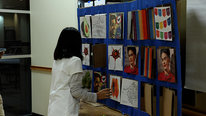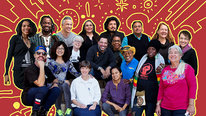- Edward Price
- https://faculty.csusm.edu/price/index.html
- professor
- Presenter’s NSFRESOURCECENTERS
- California State University San Marcos
- Charles De Leone
- Professor and Interim Dean
- Presenter’s NSFRESOURCECENTERS
- California State University San Marcos
- April Nelson
- Program Director
- Presenter’s NSFRESOURCECENTERS
- California State University San Marcos
- Sinem Siyahhan
- http://www.sinemsiyahhan.com
- Associate Professor of Educational Technology and Learning Sciences
- Presenter’s NSFRESOURCECENTERS
- California State University San Marcos
Sustaining and Expanding Mobile Making in Underserved Communities
NSF Awards: 1612775
2022 (see original presentation & discussion)
Grades 6-8, Undergraduate, Informal
The Mobile Making program physically brings Making to underserved communities by taking both equipment and university student mentors to afterschool program sites. Mobile Making is designed around research-based principles for effective out-of-school time (OST) programs and reaches approximately 750 youth each year, the majority of whom are members of underrepresented minority groups. A diverse group of university students lead weekly, 90-minute activities and serve as near-peer mentors. They provide a connection to the university for the diverse youth participants, many of whom would be first-generation college students. The program uses design thinking as a framework to engage K-12 students to solve real-world problems that are personally and socially meaningful to them using low- and high-tech tools such as circuity, coding, and robotics. Impacts include increases in the youth participants’ interest and self-efficacy related to Making and STEM, as well as their perception of the relevance of STEM/Making in everyday life. University student facilitators develop broadened technical skills, increased leadership and 21st century skills, and increased lifelong interest in STEM outreach/informal science education.
Related Content for Mobile Making: An Undergraduate Led Afterschool Program
-
 2022Playful Learning Landscapes: Informal STEM in Public Spaces
2022Playful Learning Landscapes: Informal STEM in Public Spaces
Andres Bustamante
-
 2022Centering Race and Co-creation in Community-led Research
2022Centering Race and Co-creation in Community-led Research
Marilu Lopez Fretts
-
 2022StoryMaker: Scaling STEM Inquiry Through Youth Media
2022StoryMaker: Scaling STEM Inquiry Through Youth Media
Leah Clapman
-
 2022Connecting Youth to STEM Career Pathways
2022Connecting Youth to STEM Career Pathways
John Ristvey
-
 2016Combating Chicago’s Computing Deserts
2016Combating Chicago’s Computing Deserts
Ugochi Acholonu
-
 2019The EMMET Project
2019The EMMET Project
Timothy Fetting
-
 2022Broadening Participation of Latinx Students in Computing
2022Broadening Participation of Latinx Students in Computing
Diley Hernández
-
 2022The Appalachian High Achievers in STEM
2022The Appalachian High Achievers in STEM
Rahman Tashakkori
Playlist: Sparking and Sustaining STEM intere…
Sparking and Sustaining STEM interest through Informal Learning Experiences
-
 2022From Moral Motives to STEM learning to STEM-informed action
2022From Moral Motives to STEM learning to STEM-informed action
Uduak Thomas
-
 2022Design Squad Latinx: Strengths-based Engineering Education
2022Design Squad Latinx: Strengths-based Engineering Education
Kim Gonzalez
-
 2022Broadening Participation of Latinx Students in Computing
2022Broadening Participation of Latinx Students in Computing
Diley Hernández
-
 2022Mobile Making: An Undergraduate Led Afterschool Program
2022Mobile Making: An Undergraduate Led Afterschool Program
Edward Price




Amy Alznauer
Lecturer
Good morning!
I love that you are thinking of this program as operating on two fronts – reaching students from underserved communities but also enhancing the leadership and learning of the older student mentors. Teaching is the best way to learn, yes, but it is often also the best way to find inspiration, and your program capitalizes on that in a beautiful way. The student Mhea talked about seeing that aha moment in the kids’ faces, but it was so clear that that was also a reciprocal aha moment for her. You even talked explicitly about these beautiful feedback loops, bringing students back to communities that had originally provided these students. So I have a couple questions. You mention measuring the impact on students’ interest, sense of relevance, and believe that they can do STEM. Could you say a bit about how you measure the impact on these three areas? And are you also measuring the impact on the near-peer mentors? This second impact seems at least as powerful as the first. Finally on a side note, I appreciated what Debra Brice said about the disappearance of shop and home economics from the curriculum and how there is a need for more hands-on learning. I’d love to hear more discussion (from your team or others on this forum) about that gap in curricula.
Edward Price
professor
Thanks for the comments and questions! Our assessment of interest, relevance, and self-efficacy is based on surveys, observations, and focus groups. We've written up a bit on this in conference proceedings, with a more complete article in preparation.
We have looked at impacts on the near-peer mentors, one interesting outcome is that they report being more likely to take up future opportunities for community engagement and educational outreach. Anecdotally, they experience growth in leadership and communication skills, plus a real sense of mastery. Lots more to do here, though.
On the need for hands-on learning... yes! The making and project-based learning communities really value this.
Brian Smith
Professor/Associate Dean of Research
Thanks for sharing your work!
At the end of the video, you mention wanting learners to develop interests in STEM, understand the relevance of STEM in their lives, and believe they can do STEM (self-efficacy). You also said you'd seen increases in these areas. Can you share more about how you measure these? I'm also interested in knowing more about how activities are structured to help students improve in these areas.
I love that you're sending your students back to their K-12 schools to work with younger learners. Are you studying their experiences in the schools? I imagine their own identities as STEM undergrads and community members are evolving in the maker space. Do you have any thoughts about this (maybe even from the student mentors)?
Edward Price
professor
Great questions, Brian. As I mentioned in reply to Amy's question, our assessment of interest, relevance, and self-efficacy is based on surveys, observations, and focus groups. We've written up a bit on this in conference proceedings, with a more complete article in preparation.
As far as the design of activities, we do a lot of testing to make sure the scope and complexity are in the right ballpark so that our participants will be successful. Our near-peer mentors (undergrads) are really important in designing activities - they have a keen understanding of what will be doable and appealing to our participants. Finally, we use low-cost materials because our participants have told us they want to take their projects home and share with siblings, parents, etc.
I have heard many of our undgrad facilitators say, "I wish there had been something like this for me when I was in middle school." The ability to give back to their community is really powerful and empowering for them. Being the expert and leader in a school setting is also powerful. In their undergrad classes, it may be hard for them to feel a sense of mastery (after all, just as they 'get it', we move on to a new topic), but in this program they have to chance to realize how much they have grown and learned. There is more room to study this impact.
Fran Agnone
Thanks for this great share! Can you speak more how on you prepare undergraduate students to teach in the OST space. Is there communication and expectation setting around working with K-12 staff in the OST space? Is there a set curriculum you have them follow, or are they given latitude on teaching topics that reflect their area of studies? I'm curious!
Amy Alznauer
Lecturer
Great questions, Fran. I'd love to hear more about this, too, how the undergrads are prepped for this teaching experience!
April Nelson
Program Director
Fran and Amy, I'd be happy to answer your questions! Our undergrad STEM Ambassadors are extensively trained on everything from how to build and teach the STEM making projects, the preparation and logistics related to the program (managing supplies, getting to/from the site, data collection, etc.), classroom management, and safety protocols.
The activity list for each semester's program is pre-planned so that we have consistency across all sites. This is helpful, especially as it relates to activity training for our undergrad staff/volunteers and supply management. When it comes to which activities, we do take input from our undergrad team, but the process is largely driven by one of our Lead STEM Ambassadors, an undergrad who has come up through the program and is now heavily involved in this planning. Together we ensure that our projects span various STEM concepts, can be completed in a 90-min session, and fall within our budget.
Andee Rubin
Senior Scientist
Thank you for this inspiring example of a university-community partnership! My favorite part of this project is that university students return to their community to work with K-12 students - who then have role models for how they, too, can attend college and be successful in a STEM-related field. I'm glad you're using low-cost materials so that students can further share what they made with family and friends, thus multiplying the project's impact.
I also really resonate with the lament shared by the teacher in the video that classes like home economics and shop have disappeared from the curriculum, except in vocational schools. And yet we know that, for many students, these kinds of hands-on activities with a tangible output can be more engaging than completing a worksheet. It seems to me that we've thrown out the baby with the bath water in our current educational system. While you have focused your work on informal learning spaces, it seems you some formal educators re interested as well. Can you imagine integrating these kinds of making activities in the school day, rather than saving them for after-school?
Finally, I'm wondering if there are plans for the project to continue after NSF funding ends? Is there a way to keep going without the external funds? I hope so - this project seems to be of real benefit to both K-12 students and their university mentors.
Amy Alznauer
Edward Price
professor
I appreciate your comment Andee. We do have a community of passionate teachers who include making and project-based work in their classes. I think there is plenty of room for this with NGSS, but the informal setting does give us some additional freedom in terms of content as well as prioritizing affective outcomes such as interest, relevance, and self-efficacy.
On the sustainability front, one approach we've used is having our undergrads involved through course-based service learning. They get academic credit and part of the course is designed to prepare them for their role. Another route is to work with schools as a (paid) service provider for their afterschool programs. We also have a proposal in review to develop similar programs at other California State Universities (fingers crossed!). We are excited to keep this work going!
Amy Alznauer
Lecturer
So glad Andee asked about sustainability and so good to hear you have plans for this amazing work to continue!
Further posting is closed as the event has ended.